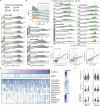This is a preprint.
Transitions in lung microbiota landscape associate with distinct patterns of pneumonia progression
- PMID: 39148859
- PMCID: PMC11326345
- DOI: 10.1101/2024.08.02.24311426
Transitions in lung microbiota landscape associate with distinct patterns of pneumonia progression
Abstract
The precise microbial determinants driving clinical outcomes in severe pneumonia are unknown. Competing ecological forces produce dynamic microbiota states in health; infection and treatment effects on microbiota state must be defined to improve pneumonia therapy. Here, we leverage our unique clinical setting, which includes systematic and serial bronchoscopic sampling in patients with suspected pneumonia, to determine lung microbial ecosystem dynamics throughout pneumonia therapy. We combine 16S rRNA gene amplicon, metagenomic, and transcriptomic sequencing with bacterial load quantification to reveal clinically-relevant pneumonia progression drivers. Microbiota states are predictive of pneumonia category and exhibit differential stability and pneumonia therapy response. Disruptive forces, like aspiration, associate with cohesive changes in gene expression and microbial community structure. In summary, we show that host and microbiota landscapes change in unison with clinical phenotypes and that microbiota state dynamics reflect pneumonia progression. We suggest that distinct pathways of lung microbial community succession mediate pneumonia progression.
Conflict of interest statement
Competing Interests The authors declare no competing interests.
Figures




References
-
- Carney S. M., Clemente J. C., Cox M. J., Dickson R. P., Huang Y. J., Kitsios G. D., Kloepfer K. M., Leung J. M., LeVan T. D., Molyneaux P. L., et al. (2020). Methods in Lung Microbiome Research. American Journal of Respiratory Cell and Molecular Biology 62. Publisher: American Thoracic Society - AJRCMB, 283–299. 10.1165/rcmb.2019-0273TR. - DOI - PMC - PubMed
-
- Dickson R. P., Erb-Downward J. R., Freeman C. M., McCloskey L., Beck J. M., Huffnagle G. B., and Curtis J. L. (2015). Spatial Variation in the Healthy Human Lung Microbiome and the Adapted Island Model of Lung Biogeography. Annals of the American Thoracic Society 12, 821–830. 10.1513/AnnalsATS.201501-029OC. - DOI - PMC - PubMed
Publication types
Grants and funding
LinkOut - more resources
Full Text Sources
